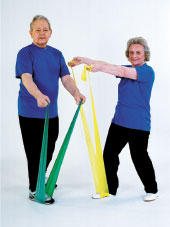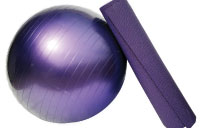
For practitioners today it comes as no shock, that not only is health
care changing, but chiropractic needs to undergo a dramatic paradigm
shift in the way we treat and progress patients through care. In the
past, manipulation, alone or supported with other passive therapies,
was considered the standard of care. With today’s evidence and current
literature, we are finding out that active care, with patients more
involved in their treatment plan, typically will support the best
outcomes.
 |
| Photos courtesy The Hygenic Corporation |
For practitioners today it comes as no shock, that not only is health care changing, but chiropractic needs to undergo a dramatic paradigm shift in the way we treat and progress patients through care. In the past, manipulation, alone or supported with other passive therapies, was considered the standard of care. With today’s evidence and current literature, we are finding out that active care, with patients more involved in their treatment plan, typically will support the best outcomes.
WHAT IS ACTIVE CARE?
“Active Care” refers to active involvement of the patient in his/her treatment. Active care is based on patient self-empowerment, and allows the patient to assist in care through three key areas: pain management, exercise and education. In the active care model, the patient plays an active role in the rehabilitation process under the guidance of a health-care provider. The key to success is patient compliance – every effort is made to promote patient self-empowerment. That responsibility is shared by the provider, by offering important education, and the patient, by understanding his/her role in the healing process.
Clinicians understand that patients will not improve with office visits alone. The patient’s activities at home are often the key to successful outcomes. By educating patients on their condition, proper posture, appropriate home exercise, and safety considerations, the practitioner can encourage patients to become involved in their care.
This is, in fact, a highly ethical way to practise because it reduces patient dependency on passive pain relieving approaches, while teaching patients the self-treatment techniques needed to develop control over their symptoms. By focusing on functional restoration and promotion of proper tissue healing – instead of promotion of reduction in symptoms – we can now achieve quicker and longer lasting results with our adjustments, because we are addressing all the underlying cause of most pain syndromes.
Although, not a new concept, rehabilitation, or active care, presents a challenging addition to the practice schedule and normal office day for many practitioners. Even though, as chiropractors, we know that compliance to, and an increase in, active care, is important for patients to ensure better outcomes, the big question is “How do I begin?”
 LOW-TECH PRODUCTS
LOW-TECH PRODUCTS
Current research clearly indicates the importance of exercise and mobility in the treatment of low back pain.1 Evans et al. found that manipulation and low-tech rehab was better than manipulation alone, or manipulation and high-tech rehab, for chronic neck pain patients.2 Although outcomes were closely matched, patient satisfaction was the highest in the manipulation and low-tech rehab group. Bronfort et al. also reported similar results that exercise and manipulation combined was more effective than either one alone.3
One of the most cost-effective ways to implement rehabilitation into your practice is through the use of low-tech products. These products require little space, are supported by the literature, and are inexpensive. Exercise balls, wobble boards/stability trainers, exercise stations, tubing and bands, and rehab wall stations are great products that can address most conditions requiring rehabilitation. Wall-mounted and floor units are an excellent way to train many of the spine and extremity conditions we see in our offices regularly. Core strengthening for spine conditions, and utilization of multiple resistance points for extremity conditions, are the great advantage of wall units. Furthermore, the literature supports the use of progressive resistance for treatment of musculoskeletal conditions as well as for improvement of function and fitness.
One of the best features of low-tech rehab products is their portability. While patients are in active care, as well as when patients have completed care, they can purchase these products from your practice and use them at home to maintain their progress. Educating patients with regards to the importance of adhering to their treatment plans – in-office rehab is very different from a home exercise program – and the importance of maintenance visits for the appropriate patient population once their active care has been completed is critical. If patients are understanding the benefits of both their continued responsibility to maintain their home exercise program, and their maintenance visits to reduce the probability of recurrences, practitioners are assured a happy, healthy patient population, as well as a healthy practice with many referrals from those patients!
WHAT THE FUTURE HOLDS
Chiropractic rehabilitation strategies need to provide a continuum of care, integrating passive and active treatments. The goal of rehabilitation should be to support and improve the effectiveness of chiropractic adjustments as well as to achieve a positive effect on the entire kinetic chain. Active care needs to be outcome driven. Your treatment plans should document and support your in-office protocols and the ongoing progress for the patient. Take charge of your patient’s care, both within and outside the office. As the practitioner, you can make sure you develop strong home strategy plans for your patients to empower them within their own care. Provide them with the right equipment and simple instructions to make it effortless to comply.
By combining expert delivery of passive and active care, along with good documentation and compliance, chiropractors can continue to position themselves as the key providers of cost-effective quality spinal care. Regardless of where you start with implementing active care procedures, there is a program that will work for every doctor and every office.
Chiropractors are without a doubt the leaders in providing the best care for their patients. By incorporating the rehabilitation paradigm into our practices we can guarantee that we stay competitive. Let’s leverage ourselves, and our profession, by learning all we can about the active care evolution revolution that is occurring.
References:
1. Twomey L, Taylor J. Exercise and spinal manipulation in the treatment of low back pain. Spine. 1995 Mar 1; 20(5):615-9.
2. Evans R, Bronfort G, Nelson B, Goldsmith CH. Two-year follow-up of a randomized clinical trial of spinal manipulation and two types of exercise for patients with chronic neck pain. Spine. 2002 Nov 1;27(21):2383-9.
3. Bronfort G, Evans R, Nelson B, Aker PD, Goldsmith CH, Vernon H. A randomized clinical trial of exercise and spinal manipulation for patients with chronic neck pain. Spine. 2001 Apr 1;26(7):788-97; discussion 798-9.
 Dr. Jay S. Greenstein received his undergraduate degree from the University of Maryland, his Doctor of Chiropractic degree from the National College of Chiropractic, and his post-graduate degree in Sports Chiropractic at the Logan College of Chiropractic. Dr. Greenstein served as the Chiropractic Representative for the National Athletic Training Association, Inter-Association Task Force for Cervical Spine Injured Athletes, and has published extensively and presented numerous original research papers at scientific symposiums throughout the world.
Dr. Jay S. Greenstein received his undergraduate degree from the University of Maryland, his Doctor of Chiropractic degree from the National College of Chiropractic, and his post-graduate degree in Sports Chiropractic at the Logan College of Chiropractic. Dr. Greenstein served as the Chiropractic Representative for the National Athletic Training Association, Inter-Association Task Force for Cervical Spine Injured Athletes, and has published extensively and presented numerous original research papers at scientific symposiums throughout the world.
Print this page